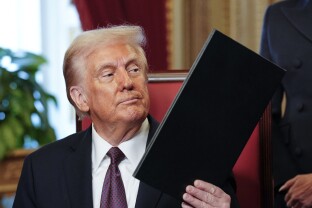President Donald Trump directed a significant overhaul of the United States’ nuclear power and safety regulation Friday, drawing cheers from industry advocates long frustrated by America’s stunted nuclear industry.
Trump signed four executive orders that direct a dramatic reorganization of the Nuclear Regulatory Commission, allow for building reactors on Department of Defense and Department of Energy land, and speed up testing of new technologies at the national laboratories. One directive also attempts to strengthen the U.S. enriched uranium supply chain, which is currently dependent on Russia.
“These are things that Congress, us and many others have been wanting to push forward here, and we’re so excited to see them come to fruition,” said Jeremy Harrell, the chief executive officer of the conservative energy innovation group ClearPath Action. The group has been in talks with different parts of the administration about the shape of these orders and what Trump can do to advance the nuclear industry.
Nuclear industry stocks rose Friday morning in anticipation of the orders. Trump’s orders could help the prospects of the American nuclear industry — as long as they don’t cause destabilizing chaos within the NRC. And then there’s Congress, which is moving forward with a reconciliation bill that currently cuts funding directed to help the nuclear industry.
The NRC has been the subject of intense scrutiny from Republicans in Congress and industry experts, who say the regulatory body is overcautious. Trump’s order requires the NRC to make decisions on nuclear licenses within 18 months, a significant cut to the average four-year timeline, and calls for significant cultural reform at the agency.
But the industry largely wants the safety regulator to remain a key trusted player, so how Trump’s proposed NRC changes are executed could be key to whether or not the orders do more harm than good.
The United States has built only two nuclear reactors in the last 30 years, which went online in 2023 and 2024 at the same facility in Georgia. China has outpaced the American industry in recent decades, with 23 new reactors currently under construction. But after decades of plant retirements and political skepticism, the industry is now experiencing a renaissance of both public opinion and new investment. Nuclear is currently the only source of emissions-free, 24/7 power that could be made widely available across the U.S. as energy demand increases for the first time in decades.
But new nuclear is also one of the most expensive sources of energy to build, so much so that utility commissioners across the country are deeply skeptical of endorsing any entirely new construction without government subsidies and guarantees against cost overruns. The Georgia reactors cost more than double their initial projected estimate, and Georgia electricity customers will be paying that extra cost in the years to come.
The Biden administration and the previous Congress attempted to address some of those problems with significant federal support through clean energy tax credits, the DOE’s loan program office, and grant and research programs for new types of miniaturized reactors that are inherently much safer than the conventional reactors operating today.
But the GOP-controlled House of Representatives shortened the timeline on the availability of those credits in the reconciliation bill it passed Thursday morning and cut funding from the loan program office. Trump’s energy department has also lost staff with significant expertise, including at the loan program office, posing a risk for the future of the industry, experts have warned NOTUS.
Still, Energy Secretary Chris Wright says that he is incredibly pro-nuclear and is determined to help the industry advance.
Friday’s executive orders mostly focus on reworking the regulatory process at the NRC and leveraging national security interests to speed up testing, innovation, and building for new advanced technologies.
A senior White House official said that the administration is hoping to see new reactors tested and deployed during Trump’s term — a significant scale-up from most projected timelines that see deployments at the latter end of this decade at the earliest. The administration plans on taking actions to revise other regulations to allow that shortened timeline to be feasible for the NRC, the official said, though they did not specify what those revised regulations would be.
Most of the advanced reactors currently in the early stages of development probably won’t speed up their timelines dramatically from these orders, Harrell said. But it is possible that the orders could get microreactors — very small nuclear reactors — running in the four-year window, he added.
The senior administration official also said that the NRC — which is usually heavily involved in oversight of new nuclear energy — will not have a direct role in the construction of new reactors on DOE and DOD land.
When asked about whether that order poses safety concerns by skirting the NRC, Harrell said that he thinks the order is “really about siting and permitting.”
“The NRC is still going to play a major role as the national safety regulator, and kind of the technical expert,” he said.
—
Anna Kramer is a reporter at NOTUS.
Sign in
Log into your free account with your email. Don’t have one?
Check your email for a one-time code.
We sent a 4-digit code to . Enter the pin to confirm your account.
New code will be available in 1:00
Let’s try this again.
We encountered an error with the passcode sent to . Please reenter your email.


